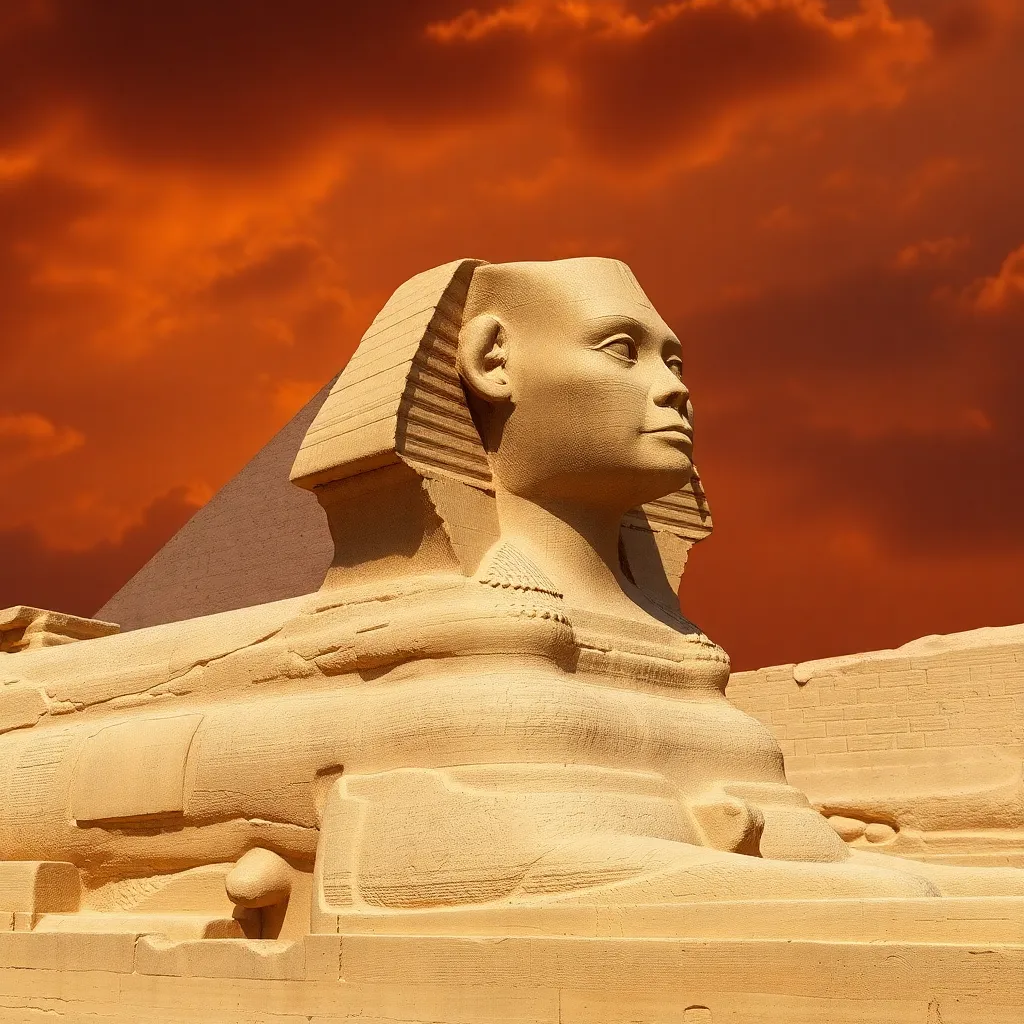The Sphinx and Its Role in Ancient Egyptian Society
I. Introduction
The Great Sphinx of Giza is one of the most iconic symbols of Ancient Egypt, representing the rich cultural heritage and the enigmatic nature of Egyptian civilization. With its massive limestone body and human head, the Sphinx has captivated the imagination of historians, archaeologists, and tourists alike.
Studying the Sphinx is vital for understanding Ancient Egyptian society, as it embodies their values, beliefs, and artistic achievements. This article explores the Sphinx’s historical context, symbolism, religious significance, role in funerary practices, representations in art and literature, and its modern-day impact.
II. Historical Context of the Sphinx
A. The construction of the Sphinx: Timeline and builders
The Great Sphinx is believed to have been constructed during the reign of Pharaoh Khafre, around 2500 BCE, as part of a complex of temples and pyramids on the Giza Plateau. The exact date of its construction remains uncertain, but it is widely accepted that it was built during the Fourth Dynasty of the Old Kingdom of Egypt.
The Sphinx was carved from a single block of limestone, showcasing the advanced engineering skills of Ancient Egyptian builders. Its construction required a large workforce and intricate planning, highlighting the organizational capabilities of the society at that time.
B. The architectural significance of the Sphinx
The architectural design of the Sphinx is remarkable for several reasons:
- Scale: The Sphinx measures about 73 meters (240 feet) long and 20 meters (66 feet) high, making it one of the largest sculptures in the world.
- Alignment: The Sphinx is oriented towards the rising sun, symbolizing rebirth and the divine connection to the solar deity, Ra.
- Integration: The Sphinx is integrated into the surrounding landscape, reflecting the Egyptians’ deep connection to nature and their surroundings.
III. Symbolism and Iconography
A. The Sphinx as a representation of power and protection
The Sphinx is often seen as a symbol of strength and authority, combining the ferocity of a lion with the wisdom of a human. This duality serves to convey the idea of a protective guardian, watching over the pharaohs and their tombs.
B. The blend of human and animal features: Meaning and interpretation
The combination of human and lion features in the Sphinx has multiple interpretations:
- Intelligence: The human head represents intellect and reason, essential qualities for leadership.
- Strength: The lion’s body symbolizes power, bravery, and the might of the pharaoh.
- Duality: This blend may signify the balance between human consciousness and animal instincts, a theme prevalent in Egyptian thought.
IV. The Sphinx in Religion and Mythology
A. The Sphinx’s connection to ancient Egyptian deities
The Sphinx is often associated with various deities in Ancient Egyptian religion. It is particularly linked to:
- Horus: The falcon-headed god, representing kingship and war.
- Ra: The sun god, symbolizing creation and life.
- Osiris: The god of the afterlife, connecting the Sphinx to the realm of the dead.
B. Myths and legends surrounding the Sphinx
Numerous myths and legends feature the Sphinx, often emphasizing its role as a guardian and a source of wisdom. One prominent tale involves the Sphinx posing riddles to travelers, echoing how it was perceived as a keeper of knowledge. Failure to answer correctly often led to dire consequences, reinforcing the Sphinx’s fearsome reputation.
V. The Sphinx’s Role in Funerary Practices
A. The Sphinx as a guardian of tombs and temples
The Sphinx was believed to protect the tombs of pharaohs and sacred temples. Its imposing presence served as a deterrent against tomb robbers and a symbol of eternal vigilance.
B. Significance in the context of the afterlife beliefs
In Ancient Egyptian belief, the afterlife was a crucial aspect of existence. The Sphinx’s role as a guardian emphasized the importance of safeguarding the deceased’s journey into the afterlife, ensuring that they would receive the protection needed to navigate the challenges that awaited them.
VI. The Sphinx in Art and Literature
A. Depictions of the Sphinx in ancient art and artifacts
The Sphinx has been depicted in various forms of ancient art, including:
- Statues: Smaller replicas were created for both ceremonial purposes and as amulets.
- Reliefs: The Sphinx appears in temple carvings, often alongside pharaohs and deities.
- Jewelry: The Sphinx motif was used in jewelry, symbolizing protection and power.
B. The Sphinx’s presence in literary works and historical texts
The Sphinx has also made its mark on literature and historical accounts. Ancient texts often refer to the Sphinx’s wisdom and its riddles, while modern literature has drawn inspiration from its mythos, cementing its place in cultural narratives.
VII. The Sphinx in Modern Times
A. The impact of the Sphinx on modern culture and tourism
Today, the Sphinx stands as a major tourist attraction, drawing millions of visitors from around the world. Its mystique and grandeur continue to inspire awe, making it an enduring symbol of Ancient Egypt.
B. Preservation and conservation efforts
Preserving the Sphinx is crucial due to environmental factors and human impact. Conservation efforts include:
- Structural reinforcement: To prevent erosion and damage.
- Regular maintenance: Cleaning and restoration of the limestone surface.
- Research: Ongoing archaeological studies to understand its structure and history better.
VIII. Conclusion
The Great Sphinx of Giza is not just a remarkable architectural feat; it is a powerful symbol of Ancient Egyptian society. Its significance spans various aspects, including religion, mythology, and funerary practices, reflecting the beliefs and values of the civilization that created it.
As we continue to study and admire this ancient monument, the Sphinx’s legacy endures, reminding us of the complexity and richness of Ancient Egyptian culture in contemporary understanding.




